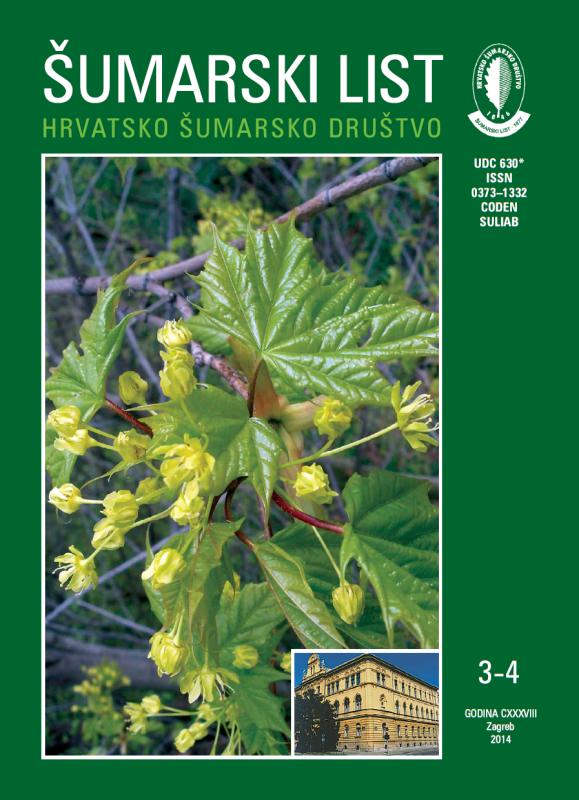
broj: 3-4/2014
pdf (8,09 MB) |
|
||||||||||||||
| RIJEČ UREDNIŠTVA | ||
| Uredništvo | ||
| THE STATUS AND POSSIBILITIES OF A MORE ACCURATE EVALUATION OF FORESTS AND FORESTRY AS PART OF THE ECONOMY OF THE REPUBLIC OF CROATIA pdf HR EN | 121 | |
| IZVORNI ZNANSTVENI ČLANCI | ||
| Jura ČAVLOVIĆ, Krunoslav TESLAK, Karlo BELJAN | UDK 630*569+653+231 (001) | |
| THE EFFECTS OF DIFFERENT STAND REGENERATION PLANNING ON MANAGEMENT AND PEDUNCULATE OAK FOREST DEVELOPMENT – A SMALL SIZE MANAGEMENT CLASS CASE STUDY pdf HR EN | 123 | |
| Dalibor Ballian, Alma Hajrudinović, Jozo Franjić, Faruk Bogunić | UDK 630*164 (Quercus trojana Webb.) (001) | |
| MORPHOLOGICAL VARIABILITY OF THE LEAVES OF THE MACEDONIAN OAK Quercus trojana WEBB.) IN BOSNIA AND HERZEGOVINA AND MONTENEGRO pdf HR EN | 135 | |
| Krunoslav Arač, Milan Pernek | UDK 630*453 (001) | |
| OCCURRENCE AND SPREADING OF THE LARGE LARCH BARK BEETLE (Ips cembrae) IN CROATIA AND POSSIBLITIES OF MONITORING BY USING PHEROMONE TRAPS pdf HR EN | 145 | |
| Summary The large larch bark beetle (Ips cembrae) is a secondary pest species which tends to build outbreaks in certain condition particular after drought stress or thinning. If enough suitable material is available in the forest, population density starts to grow and in lack of weakened trees the bark beetles attack healthy trees. In such circumstances this beetles are considered as primary pests. Regarding new problems with this bark beetle species in Croatia and trends of environmentally friendly forest protection measures, it is essential to determine the occurrence and possibilities of population spreading of the large larch bark beetle and gain new knowledge about possibilities for using pheromone traps against this pest. The results are showing occurrence, distribution and damage of large larch bark beetle in Croatia. Although large larch bark beetle has been mentioned in several publications as present in Croatia, there is no provable evidence of this because no locality has ever been given neither in publications nor entomological collections. Therefore the record of large larch bark beetle in Koprivnica on European larch (Larix decidua) in October 2008, could be considered as the first record of this pest species in Croatia. The large larch bark beetle was recorded from 2008 till 2013 at 24 forest sections in 7 Forest districts, in 23–58 old stands at elevation of 160–350 a.s.l. The distribution map shows the infection spreading which amounts up to 17km yearly. For monitoring purpose pheromone traps (Theysohn®) baited with Cembräwit® were installed in 2011. The monitoring was observed trough the vegetation period from 2011 till 2013 which is the first pheromone trap monitoring of this species in Croatia. It was found that the first generation is swarming in middle April. Further only one generation was recorded till 2012 and just in 2013 a second generation occurred in August and September. The damage of this pest was assessed by number of marked trees and timber volume of felled trees. In total 4.922 larch trees were infected which is 2.121m3 timber volume. The majority of timber volume was marked for felling in 2012 and 2013 probably influenced by drought combined with high temperature and very long periods without precipitation. In such conditions larch trees were highly stressed and physiologically weakened. This was the trigger for bark beetle attack. In the coming years a further spreading to new locations in Croatia is expected. Key words: Ips cembrae; Larix decidua; Theysohn®; Cembräwit®; pheromone trap; bionomy | ||
| Maja Popović, Mladen Ivanković, Saša Bogdan | UDK 630* 165 + 181.8 (001) | |
| VARIABILITY OF HEIGHT GROWTH AND SURVIVAL OF PROGENIES FROM PEDUNCULATE OAK (Quercus robur L.) SEED STANDS AT THE FIELD TRIAL ‘JASTREBARSKI LUGOVI’ – FIRST RESULTS pdf HR EN | 155 | |
| Ivana Vitasović Kosić, Mihaela Britvec | UDK 630*187 + 268 (001) | |
| FLORISTIC AND VEGETATION CHARACTERISTIC OF FOREST EDGES AND GRASSLANDS OF ĆIĆARIJA (CROATIA) pdf HR EN | 167 | |
| PRETHODNO PRIOPĆENJE | ||
| Manana Kereselidze, Slavimira Draganova, Daniela Pilarska, Andreas Linde | UDK 630*453 | |
| SUSCEPTIBILITY OF Lymantria monacha AND L. dispar TO THE ENTOMOPATHOGENIC FUNGUS Isaria fumosorosea WIZE pdf HR EN | 185 | |


